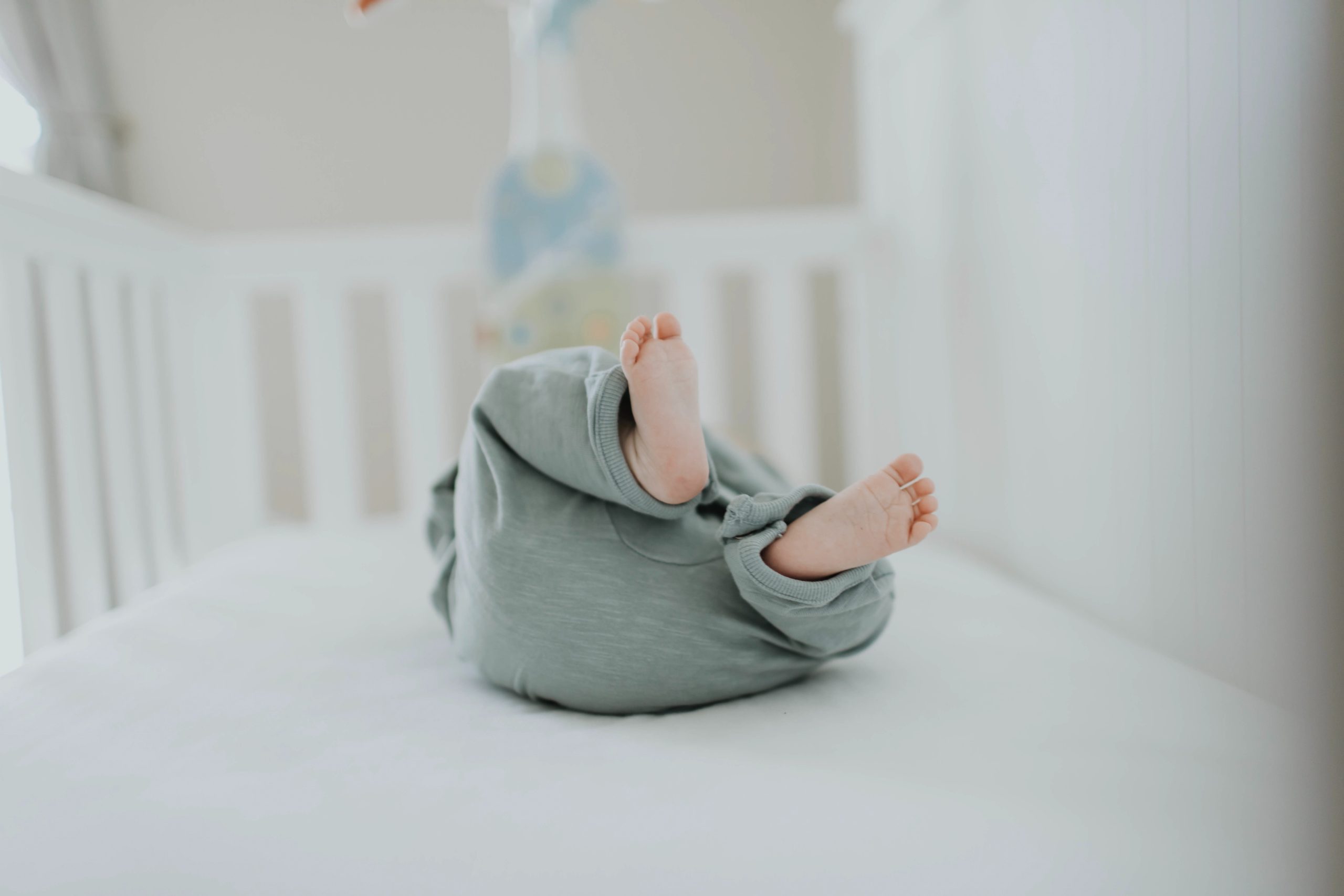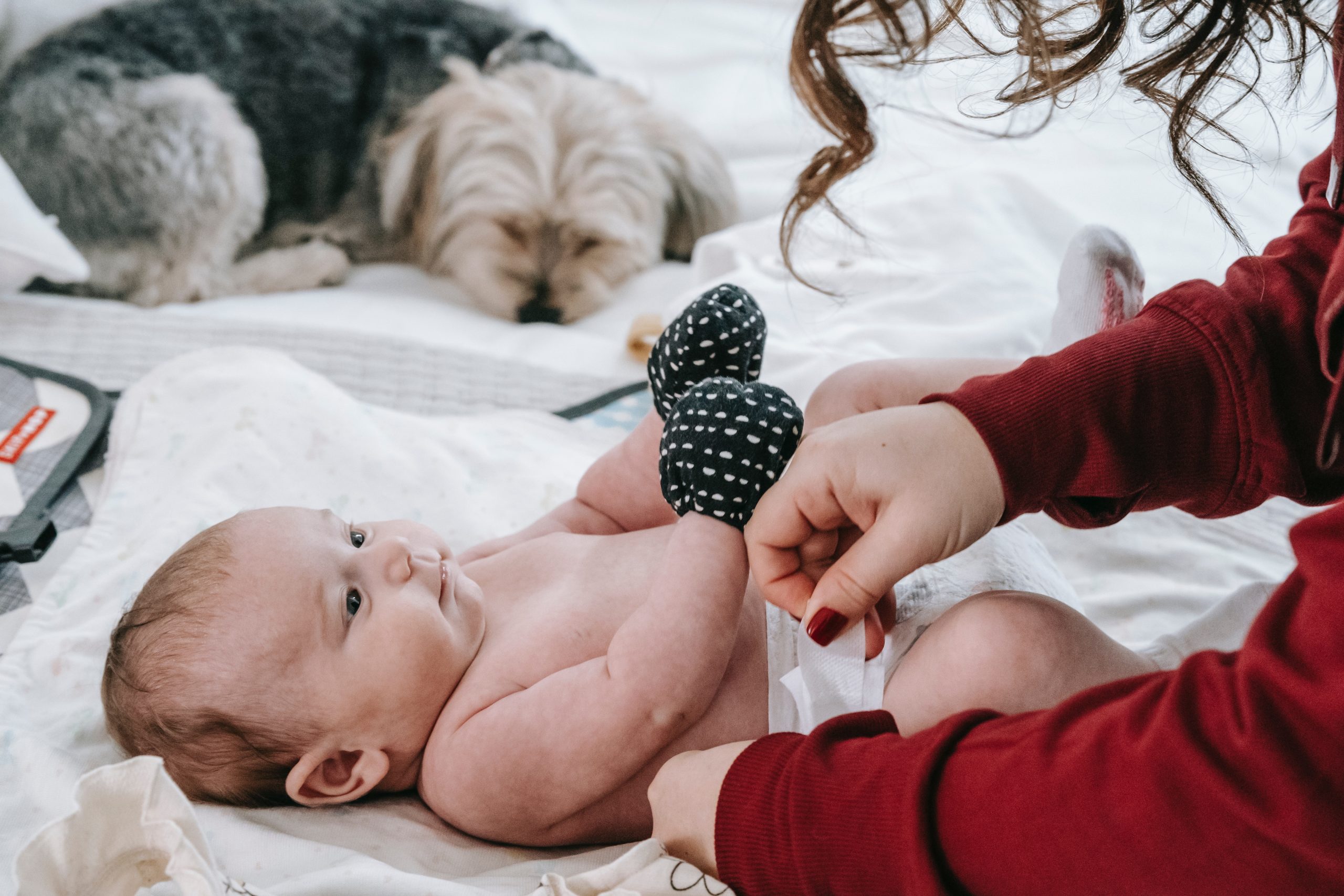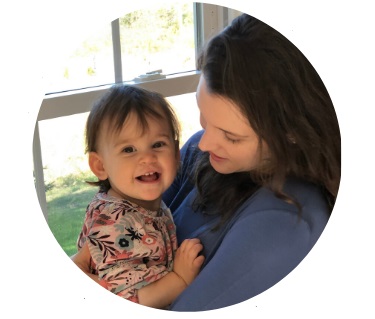Where should you start when you’re asking yourself “why won’t my baby sleep?” Their sleep environment. Like many newborns, my two daughters could sleep anywhere, anytime for about the first 3 months. Then gradually they became more and more sensitive to their sleep environment. You can solve a lot of your baby’s sleep issues like we did if you know how to create the ultimate setting for sleep.
Here are all the components of a good sleeping environment, which will set you up with the perfect foundation to create excellent sleepers.
1. White Noise
We purchased a white noise machine when we set up the nursery and have an app on our phones. The idea behind white noise machines is that the womb is noisy so most babies have a hard time sleeping when it’s quiet. The noise is similar to the noise they hear in-utero.
You can actually get a bear that mimics utero noises with a heartbeat to add to baby’s crib, I didn’t learn about this soon enough to make use of it with my daughters, but some friends of mine have had success with it. The second reason behind white noise is that it cancels out all of the noise and voices in the house that could jolt baby out of sleep. Be aware of how loud your machine is and ideally place it on the opposite side of the room so it isn’t damaging your baby’s hearing.
2. Temperature
A well-regulated temperature is a must. If you are hot or cold, you throw a blanket on or off. A baby can’t do this. In fact, with my kids it wasn’t until they were about 3 years or older that they understood this.
We always struggled with this. I would either dress my kids too warm or too cold. A sleep sack is tremendously helpful in keeping little ones warm without overheating. In fact, not getting your baby accustomed to a sleep sack now could cause sleep issues as a toddler, because they won’t be used to wearing anything while sleeping. They come in sizes from newborn to XL for toddlers, I highly recommend trying one.
Another tip is to use footie pajamas with inverse zippers. I was so happy when I found some. When you change the baby in the middle of the night, it is so nice to only have to unzip to their tummy and then pull aside the pajamas. When the zipper is the traditional way (bottom to top), you have to unzip the full zipper and then rezip, which takes more time. The biggest advantage to the inverse zipper is that by only unzipping to the tummy, they stay warmer and are less likely to get upset/wake up more.
3. Feeling Secure
Using either a swaddle, Magic Merlin Sleep Suit, or a sleep sack AND a lovey will help little ones sleep. These outfits are a great way to keep baby at a good temperature and help them feel cocooned and secure. We went from the swaddle (0-3 months) to the Magic Merlin Sleep Suit (3-7 months) to the sleep sack (7 months and on). You can also use a sleep sack from 0 to 3 if your baby doesn’t like their hands trapped. However, I still highly recommend the Magic Merlin Sleep suit from 3 months on because it does such a great job to transition baby to a crib. The Magic Merlin Sleep Suit did us wonders however I don’t feel it is ever recommended enough with how well it works.
The power of a lovey
Between months 6-10, baby will attach to a lovey. A lovey promotes independence because eventually in the middle of the night if the child can find their lovey, they usually can fall back asleep. It is important to not miss this window as your baby will attach to something at this age and if they don’t have something it could be YOU or YOUR HAIR.
When can baby sleep with lovey?
The American Academy of Pediatrics does not recommend having a lovey in the crib until 12 months. Like everything, use your best judgment. All kids reach milestones at different ages. Do only what you are comfortable with.
How to introduce a lovey
Here are some options to get your child comfortable with a lovey:
- Nurse with the lovey. Even if you don’t allow baby to sleep with the lovey, nursing with the lovey will start that association of comfort, and the lovey will smell like you and milk.
- Do the lovey test: Once your child is asleep, place the lovey on their face and see what they do. See if they grab it and move it off their face. Try this a couple of times.
- Include the lovey in your bedtime routine, nurse with it, and read stories with it so baby associates the lovey with bedtime and you.
- Allow baby to fall asleep with it but watch on the monitor to ensure baby is safe, then once baby falls asleep remove it. Then once baby is 12 months, you can go ahead and switch to them having it all night.
4. The Lighting in The Sleeping Room
The lighting in the room that baby sleeps is important. I would highly recommend purchasing blackout curtains. Blackout curtains allow you to darken the room for naps and for bedtime when it might still be light out as most babies will go to bed as early as 5 or 6 pm.
However, I suggest adding a dimmable nightlight specifically near the changing table for two reasons. One is that most babies don’t like complete pitch black. The second is when baby wakes during the night, it is important to keep the environment as calming as possible. You don’t want to have to turn on lights to change a diaper (or nurse) and really wake baby up.
5. The Lighting of ANY Room After Dinner Time
You want to ensure that the rooms that you are in are becoming darker as the sun sets. This helps baby to start to settle down and get ready for sleep. They follow the sun like clockwork and being in a bright stimulating room only hurts your efforts to put baby to sleep. We would usually do a walk around the block and put baby in an Ergo Carrier after dinner to start our bedtime routine. Being outdoors would always soothe our daughters (as it does most babies) as the world around them would naturally darken.
6. Check Your Emotions and Attitude Towards Bedtime
Baby knows when you are anxious or frustrated. I know it is challenging but take a deep breath and try to convey to your baby that going to bed is a wonderful thing. You want baby to feel safe, calm and happy about sleep and they will mimic your feelings. Smile at your baby and show them that sleep is a not something to be afraid of. If you become very anxious and have a look of worry on your face every time you put them in their crib, they will associate their crib with fear and naturally scream and cry.
7. The Crib or Not The Crib
As always ensure the sleeping “bed” is safe for baby, whether this be a co-sleeper, crib or bassinet. In addition to safety, as baby gets older continually check if the “bed” might be the issue. For instance, our first was a big baby. She was wearing 2T clothing before 12 months. She also moved a ton at night and as a result the crib was actually causing a good number of wake-ups. She would either get an arm or leg stuck or just bump into a side and it would wake her.

The solution? We moved her to a Pack n Play where the sides are mesh. She LOVED it and slept better than she did in her much more expensive crib. If you don’t already have one, I highly recommend getting a Pack n Play. They are great for babies who move a lot at night and are also great travel cribs.
Another bonus is when you are traveling and the sleeping environment is new, the “bed” won’t be, and baby will be comfortable in their Pack n Play. Test out a few options and see what baby likes best, as some babies do indeed do better in the crib.
8. Make The Crib A Pleasant Place
Have baby spend a few minutes each day in the crib outside of nap and bedtime. Add a fabric book to the crib or a few loveys to choose from or put a mirror up on the side. Another good addition is a mobile that sings. Our favorite one is also portable and was wonderful in the car.
Once your baby is older, around 6 months or so, and can crawl or sit and start to play a little, give them a few minutes when they wake to play independently in their crib. Then when you go to get them, make sure you are just as happy as when you put them to sleep, even if you are frustrated their nap was short. Remember positive associations with crib and sleep are important.
9. What to Say at Night
Try to limit talking to your baby especially after the bedtime routine. Only say one or two words. Pick something like goodnight, I love you, night night or time to sleep. Even for diaper changes and nursing during the middle of the night, this helps baby know it’s still time to sleep.
10. Diapers Matter
As a newborn you can expect baby to be waking up for diaper changes. Diaper changes are also a good thing because baby is hydrated and healthy. What you need to determine is: when are diaper changes causing unnecessary wake ups? If your baby has a diaper rash, the rash could be bothersome to baby when the diaper is wet and could be causing a problem. Try to clear it up with some good cream applied with a baby bum brush or check with your pediatrician that it isn’t a yeast infection.

Second, if you are using cloth diapers or diapers NOT ideal for night, then you might be costing yourself some sleep. Cloth diapers are great but if you have a child who pees high volumes, cloth diapers just can’t compete with regular diapers on keeping baby’s skin dry and rash free. I would try regular diapers overnight and just use cloth during the day.
My favorite diaper to help baby sleep through the night
The best diapers I have found are Ultra Guard Luvs. We had a lot of issues with rashes until we switched is Luvs. We received some other brands of diapers from friends when their kids outgrew a size and if it wasn’t Luvs, our kids would always ends up with a rash. We use Amazon Family through Amazon because we save money 20% on diapers by using a subscription, and we also don’t have to remember to restock. Switching to this brand cleared up the rash issue with our older one and we avoided it completely with our second. Better yet, when we switched from cloth to this diaper, our first went from waking four times a night to only twice a night.
Pursue Better Baby Sleep Today
After reading this, hopefully you can start to answer the question of “Why Won’t My Baby Sleep?” Of course, none of these tips are a silver bullet, but hopefully one or more of these tips can help your baby (and you!) get more sleep every night.
If there are any baby sleep tips I might have missed, let me know in the comments!
If you found this post on Why Won’t My Baby Sleep helpful, please share it on Pinterest or Facebook


I am a wife, teacher, and mother to two awesome girls. I write about what I am passionate about, which includes being a mom, house projects, beauty and skincare. I love to share my experiences, failures, and successes with my readers. Let this space be a resource for you to pursue your very best day.

Jemuel Idanan
Wednesday 13th of September 2023
Thanks
The 7 Colic Baby Remedies That Helped My Newborn
Tuesday 15th of November 2022
[…] PLEASE do not worry about creating bad sleep habits, because during the newborn stage you can’t. First, all sleep professionals agree that sleep training should never be done before 4 months, and some say even 6 months. No matter your opinion on the method, your focus should be on you and baby learning about each other and to increase your supply to ensure breastfeeding is a success. Having a colic baby makes things extra challenging so just focus on the present and trying to find ways to make these months easier. When it’s time to focus on sleep, check out my post on creating a perfect baby sleep environment. […]
Why Mom Blogs Failed Me on Baby Sleep - Pursue Today
Monday 14th of November 2022
[…] Work on sleep by doing reps and you will never have to make this decision to just let baby cry for hours. You won’t run into a wall because you are slowly working on good sleeping skills every nap and every night. For tips specifically regarding the baby’s sleep environment, check out my post on why won’t my baby sleep? […]